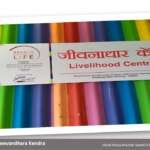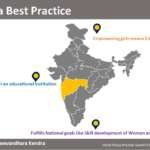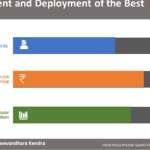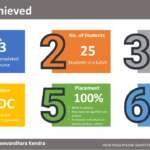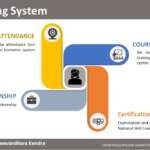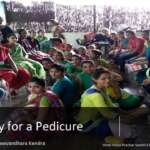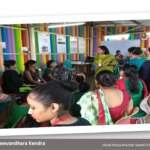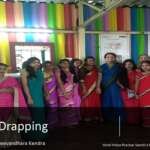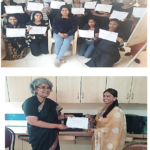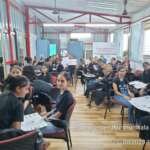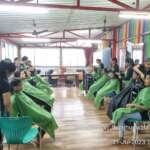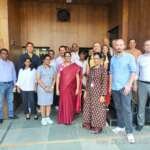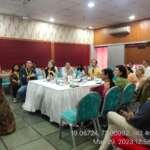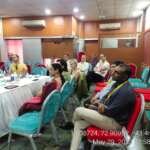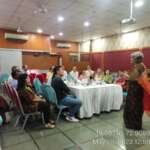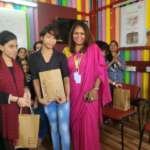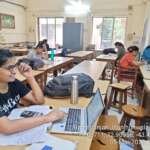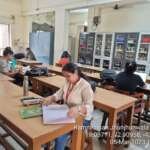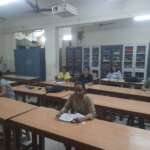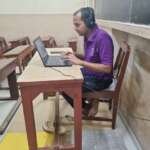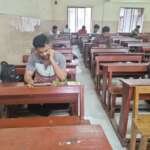Best Practices
Annual Inter Collegiate Training by Library for Library Support Staff
Annual Inter Collegiate Training by Library for Library Support Staff
Capacity building of Library Support Staff to train them with the Information services rendered by Library in a rapidly changing requirements in higher Educational Institutions.
Libraries are now known as Learning resource Centers. Libraries are no more a centre for collection of books but go beyond that by providing the reader/learner a pleothera of information to enrich their learning experience. In Higher Educational Institutions the learning resource centre has manpower which constitutes of the Librarian, Assistant Librarian, Library clerk these are trained in Library Science but the support staff of Library Attendants and Class IV employees have no training in the required skills for working in the Library. In view of this the capacity building program of training library support staff was initiated 15 years back.
For the last 15 years the Intercollegiate Annual Training for Library support staff is planned by the team led by the Librarian. Invitations are sent to HEI in Mumbai, Maharashtra and other states. The training period is of 7 days and it commences from 24th December every year and end on 30/31st December with a new year resolution to provide best services to our learners when we return to our own Institutions. The training has sessions on the emerging areas in Library, digitalization, using new softwares for automation, online services, conservation of rare books, ethics. There also sessions on personality development, communication, stress management, anger management etc. The training ends with an examination for the participant and top three are awarded prizes all particpants get a participation certificate. The training also includes a visit to a library of another reputed Institution in Mumbai.
The very fact that every year the training program attracts participants from different parts of Maharashtra and few from other states is a significant achievement. Our Library support staff look forward to this training program. Any practice which is initiated for quality and is institutionalized becomes the institutional best practice.
The only problem is of generating money for the training program. A nominal charge is collected from the participant. The College has been spending for hospitality of the participants and honorarium for the resource person. Since accommodation is expensive in Mumbai outstation participants are provided with free of cost accommodation in college premises. To take care of the expenses this year 2023 book exhibition was organised and the book dealers provided with sponsorship which could partially take care of the expenditure
Open House for students to view their answer sheets.
Open House for students to view their answer sheets.
To bring transparency in the evaluation process and provide opportunity for students to improve.
Evaluation reforms includes providing opportunity to the learner to improve. Learner must get an opportunity to realize what was expected by the evaluator. In view of this the IQAC and the examination committee deliberated that students must be able to see the evaluated answer books after every semester and discuss with the teacher how they can improve or if they feel that they should have scored better they have an opportunity to discuss with the teacher.
R J College was given autonomous status in June 2018. This provided an opportunity to implement several reforms in the evaluation process some of them being continuous evaluation, different modes of evaluation to assess the learning outcomes. Different techniques of evaluation for special children to name a few. One such reform was to conduct an open house and let the learner have an opportunity to see the answer books and teachers would discuss with them the model answers and also solve their queries. After the answer books are evaluated the examination committee prepares a time table for open house class wise and roll number wise and informs the students. Teachers who have evaluated the answer sheets are present during open house. The non teaching staff segregates the answer sheets paper wise roll number wise. Students come and collect their answer sheet are given time to go through their answers sheets and discuss with the subject teachers. Teachers also give them important information on how they can improve their performance.
The most significant evidence of success is negligible grievances received whether it is for mark verification or revaluation. Grievances are nil especially in the qualifying exams. Students have expressed satisfaction over the evalution process as is evident from the feedbacks obtained from them.
The main problem encountered initially was teachers preparedness for open house but it they soon overcame this since it automatically brought in more accountability careful in totaling, when large number of papers are corrected by a teacher. Another issue was safety and security of answer sheets and ensuring students don’t tamper with it. This again was resolved by empowering students to be responsible. No extra expenditure incurred. The main resource requires is human resources and time. Our teaching and supporting staff fully supported this initiative and now it is successfully implemented for all the semesters.
Starting of a Livelihood center “Jeevandhara Kendra” for empowering girl students in collaboration with Sambhav Foundation a CSR initiative of L’Oreal
Starting of a Livelihood center “Jeevandhara Kendra” for empowering girl students in collaboration with Sambhav Foundation a CSR initiative of L’Oreal
Ramniranjan Jhunjhunwala College caters to the marginalized section of the society. More than 50% students are female. Many of them are from the minority community. Through mentors and counsellors, it was realized that they did not have much support from family members and coupled with this the girls are also academically average. Remedial programs, better communication skills through English speaking classes, computer literacy did not show any measurable results. Its human to look presentable and business of beauty is ever increasing. L’Oreal is a multinational company well known for its work on women empowerment. Beautiful beginning a CSR activity of L’Oreal which they conduct through Labornet and Sambhav Foundation, an assessing agency recognized by National Skill Council. The center is now known as Livelihood center (Jeevandhara Kendra).
The major problem is to provide space for a beauty center and a class room for conducting classes. Scheduling of timings for this new initiative without compromising with their academic schedule. Security of girls specially when they are sent out for internships. Initially the girls common room was but was a short lived for several reasons. Finally, when the terrace was covered for solar panels the space below that was identified for the beauty center. The center catered to only our students but we soon realized that we need to extend a helping hand to the women in the society, so the enrolment was opened for all.
Girl students who are pursuing undergraduate studies and mainly from arts and commerce streams are screened for their economic background those belonging to income group less than 50,000/ per annum are chosen in a batch of 25-35 and in a day two batches are trained. The college has provided with space, free water and electricity, infrastructure like chairs, computer, white board etc., L’Oreal provides them with all consumables of high standards, non-recurring items like reclining chairs, mirror, all equipments for beauty treatments. The training is of six months’ duration of practical and theory and are sent for internships. Attendance is monitored digitally. An examination as per requirements of National Skill council is conducted and they are awarded certificates. The program is running successfully for last one decade. Pandemic did not deter us from continuing with this program so training was provided online for two years and from 2022 things have bounced back to normal.
Students have successfully completed the course. Girls are more confident, and they look presentable. Many of them are placed and some of them are entrepreneurs who have started their own parlours. The trainers also provide training to students for special occasions. These students present fashion shows and help in all our cultural festivals of the college. This facility is now extended to other females who are not studying in our college but are economically challenged. As an institution of higher education this is our small way of giving back to society by empowering the women. The initiative was presented to IMC Ramakrishna Bajaj Quality Assurance as making Quality happen and we won the second runner up prize under the category of Best practices in Educational Institutions.
The academic year 2022-2023 had visitors from L Oreal who interacted with the students for gap analysis. They expressed their satisfaction and expressed their gratitude to the Institution for all the support rendered We had two surprise visits wherein the Team L’ Oreal Paris visited our center on December 14, 2022 and April 12, 2023 and interacted with student’s trainer, past students came and shared their experience success stories. On 29th May, 2023 the team from L’ Oreal and Accenture visited the center and appreciated the college for this unique initiative. The team was accompanied by the founder of Sambhav Foundation Dr Gayathri Vasudevan who has empowered many women. All this has culminated in establishment of a center in our college for advance global training in Hair dressing.
The main problem was security of girls. CCTV are installed in the terrace and supervisory rounds are taken. Establishment of infrastructure required funds which is provided by the management. All electrical bills, maintenance on a regular basis is taken care by the college.
Reading room facility for students in the college
Reading room facility for stdents in the college
To create an ambience of joy of learning by providing a safe haven for students of our college as well as from the community to study
- Provide an ambience for reading and encourage reading habits among the youth
- Space constraint in Mumbai city, students living in slums, noisy neighborhood, family issues, shared washrooms, problem of basic facilities at home.
- To create a space where students study peacefully, make new friends, peer teaching- learning.
- Encouraging students to achieve their goals is in line with Institutional mission.
Our College timings are from 6.45 am to 6.30 pm. The MA, M Com and CMA classes are held in the evening. After classes rooms are to be cleaned and kept ready for the next day morning classes. Planning for cleaning and maintenance was done to allot two classrooms. The main challenge was security of the students since the reading rooms are open till 11PM on all days which includes Sundays, holidays, vacations and even festivals like Diwali, Eid etc. Two classrooms are allotted to the boys on the third floor or on second floor. For girl student’s bioscience laboratory is provided in view of the security and proximity to college office and girls common room. One support staff of bioscience department is available till 11PM In addition, few staff involved in housekeeping are available till 10.00 PM. The entire premises and these rooms are under CCTV surveillance and there are two trained watchmen who take supervisory rounds.
The reading room facility is mentioned on the college website and students approach us with a request. They are our own students as well as students from other colleges. Students approach to avail of the reading room when they are pursuing professional studies like engineering, medicine, preparing for competitive examinations, MPSC, UPSC etc. For the students preparing for CA, CS, Cost accounting it’s a favorite place since they can also discuss and learn from each other. The reading room has gained popularity among the students. Those who have availed the facility come back to just spend some time and go back down their memory lane. These students are well placed and share their nostalgic memories. They also express their gratitude to the college for providing this facility. Students make a formal application, and they are provided with an Identity card to enable them to use the reading room. This facility is provided absolutely free of charge. Students are provided with well-ventilated rooms with proper lighting, clean filtered drinking water, clean washrooms. Newspapers are provided to students who are preparing for competitive examinations. The reading room was kept open when the lockdown was relaxed during the COVID Pandemic by following all safety measures as per protocol. The method of granting permission from manual form filling has become digital and student can scan the QR code for form. They are issued an identity card for entry.
The reading room is a popular place for students who have a desire to study and excel. Almost every day there is an application for the reading room. A sense of bonding develops among the students, and they learn to share. The reading room provides the desired ambience for reading in the era where television, social media, mobile have replaced reading. Reading habits are dwindling, this is one effort to encourage reading habits. Students preparing are very focused and they can study without being disturbed. They have completed their desired program and some of them have excelled by achieving ranks in the examinations.
The main problem is to locate rooms for reading room. The Governing Body and authorities had to be convinced due to inbuilt challenges like security and discipline. The supporting staff must also be involved otherwise the practice would have been short lived. Students were counselled to maintain discipline and cleanliness. For cleaning the rooms given as reading room, housekeeping staff had to come early so that before classes begin in the morning it would be clean. No additional financial resources are needed except a positive attitude of everyone in holistic development of youth by providing the resources for development.
Just in Time Teaching
Alumni engagement by involving alumni in college activities
To encourage students to come prepared for the class and also play a participatory role in the teaching learning process.
This generation ‘Y’ is increasingly technology and electronic oriented. This generation can grasp things which are visual and which are given to them in the form of a video/animation or small presentations interspersed with visuals. In the class room visuals were found to keep the learner attentive but retention of information was not adequate. It was observed that the learner was not actively participating in the learning process even though an electronic media was used for instruction. Some of our teachers felt if they send the learning material in advance mainly in the form of videos, will it help the learner and involve him to a greater extent. This was found to be of a great learning experience for the learner as well as the facilitator. This Just in time teaching has helped students to participate in the teaching learning process.
In our Institution “Just in Time teaching” has been practiced by some of our teachers to increase greater class room interactivity. The teacher sends videos at least one week before the actual class. The number of videos ranges from three to four, some of these videos are simple and some dealing with the complexity of the topic and sometimes presentation with animations and informs the class to view them. Students are sent instructions tonote the information with reference to what they have learnt from the material sent to them. They are encouraged to formulate questions based on aspects that they have not understood. The learner is provided with at least a week’s timeso that they can view the material and try to understand. In the class initially students are given a small assignment to understand how much they have learnt and what are the issues that need to be tackled. The topic is the dealt with at greater length with greater participation of the learners. These assignments also are indicators of the level of understanding of the learners (slow and advanced learners). The classroom becomes interactive and discussion leads to greater learning.
It has been observed that there is increased participation of the students in the teaching learning process. The students have also started searching for study material using the world wide web. Since the students are given assignments they are actively participating in the learning process. The performance of the students in the topics in which Just in time teaching is practiced has shown improvement which is measurable. COVID 19 lockdown resulted in students being off campus and studying online this practice helped students in understanding and interpreting the topics in a better manner. It also helped them to apply what they have learnt.
The main problem encountered is non availability of Android phone with very student. The students found a solution for this problem and started sharing their mobiles and using the computer laboratories. While they shared the mobile phone, they also discussed what they learnt from the video and in turn they have started explaining each other and searching for new information related to the topic. Since the campus is Wi-Fi enabled students started spending more time learning so they can contribute to the discussion when they come to the class.
Strengthening Alumni engagement
Alumni engagement by involving alumni in college activities
To promote greater alumni interaction with the institution leading to strengthening of alumni engagement.
Our past students (alumni) are very fond of their alma mater and recall their memories as and when they visit the college. There is a strong institutional loyalty since they bring back their own children, siblings, relatives to our college for admissions to various programs conducted by the college. The past students of NCC always join on Independence Day and republic day parades. The past students of NSS come to assist the current batch in organizing street plays, extension activities. To formalize the alumni engagement the alumni association was registered. For a six-decade old college with alumni in prominent positions in terms of alumni engagement more is expected.
Hindi Vidya Prachar Samiti’s Ramniranjan Jhunjhunwala college established in 1963 and since then has enabled many students to be achievers in different areas. Our alumni are well known medical professionals, engineers, politicians, advocates, judges cricketers etc. To name few of them well known International cricketers like Mr Balwinder Singh Sandhu, Mr Sanjay Bangar, Mr. Paras Mamre, former editor of Loksatta Kumar Ketkar, Science writer with Times of India Mr. Vitthal Nadkarni, the former school education minister, Government of Maharashtra Ms Varsha Gaikwad, former Vice Chancellor of University of Mumbai Dr Sanjay Deshmukh, former Registrar University of Mumbai Dr P V Pradhan, educationist Dr M R Kurup former Principal KET’s Vaze college, The Deputy Director of Wild Life Institute Deharadun Dr Yadvendra Jhala, Ex R&D Head of Biocon Dr Narendra Chirmule, Dr Priya Chatterjee Head Asia Pacific Regulatory affairs Bayer, famous singer Mr Vikram Hazra, and many more. With illustrious alumni we realized that we need to engage with our alumni more effectively and formalize this engagement. A decade back we started inviting at least five illustrious alumni and felicitating them at our annual academic prize distribution function. This gave an opportunity for the alumni to have a dialogue with our current batch of students and they shared their experience. Similarly, during the Gymkhana Day Prize distribution function our alumni sportsperson were invited as a special guest and felicitated. We hired our alumni as cricket coaches. Every department organizes career counselling sessions of which at least one session is conducted by alumni who are achievers, and they provide career guidance to the students. Departments have also named these sessions in their unique manner as “Anubhav Ke Bol” ‘Hum Honge Kamyab’ etc. Our celebrity students come as guest during the cultural fest to motivate and cheer our student performers. Recently our college initiated the Swayamsiddha award to be given to a women achiever, this has a dual purpose one to felicitate our alumni women from different areas and second as a mean to encourage women empowerment and motivate our girl students to be achievers in their own area of interest. The first award was given to Ms Rohini Athavale for her work in the area of Skin Donation specially for the Burn victims through her NGO, last year the award was given to our alumni Ms Mamta Mishra Kulkarni the first women station master she manned the all women station at Matunga, Mumbai very efficiently. This year the award was given to Ms. Vidya Phalke, Best teacher awardee at the National level for her extraordinary contribution to school education. These activities have led to greater involvement of our alumni with the institution and the bond is strengthened. Our illustrious alumni working in Industry are invited for project guidance, guest lecture sessions to rekindle their memories of campus life.
Our past students who are well-known doctors organize annual free medical camp for the members of the staff and students. They also organize sessions on health-related issues for our staff and students. Our past students help in placements of our students. They provide students with internships and whenever positions are available in their organizations they immediately bring them to our notice. Our former NCC cadets regularly join us in our celebrations on Independence Day, Republic Day, and Shastra Pooja during Dusshera. They help us by joining in the annual cycle expedition organized by the NCC cadets. Our alumni deliver guest lectures to appraise students of the recent trends in technology and help in training students for smooth transition from campus to corporate. Our past students have been contributing to the endowment funds to the Hindi Vidya Prachar Samiti the managing trust as prize money to be given to meritorious students. With autonomous status being granted to the college all subject Board of studies have illustrious alumni who contribute to curriculum design and help in placements.
To contact alumni and to organize meetings so as to bring the alumni together has been a difficult task in view of the time constraints and travel-related issues in Mumbai. Another major problem is the lack of databases since many alumni are not registered members. However, efforts are made to bring them together at least department wise. Alumni have responded as when the institution needs them. It is not a problem but a matter of concern that alumni of conventional HEI have not donated any significant amount or contributed to establishing a chair which as of now practiced in Universities and Institutions like IIT’s.
Plethora of co and extracurricular activities organized by the Associations and clubs for capacity building and skill enhancement of students for their holistic development
Plethora of co and extracurricular activities organized by the Associations and clubs for capacity building and skill enhancement of students for their holistic development
Holistic development of students by curriculum enrichment through co-curricular activities and hone their talents by organizations of competitions. To enable students to be sympathetic and empathetic activities are organized by Associations and clubs and sensitize students to the needs of the society and learn from role models, patriotic leaders, scientists and scholars by celebrating commemorative days.
College life is not about just academic learning campus experience gives a student an opportunity to grow up as a responsible adult contributing to nation development. With advent of technology communication is more remote and has less individual interaction. Our college has a rich heritage of engaging students more meaningfully by involving them in every activity which is organized by the college associations and clubs. This also brings students across faculty to come together and learn life skills from each other.
The Practice: Six decades back when college started from the munificent funds collected by the efforts of a postman and some like minded citizens of Mumbai catering to needs of marginalized section of the society, the only place away from home was the college which provides a safe haven and gives opportunity to every student to grow as a responsible individual and contribute to the society. To enrich the curriculum and to provide maximum students to participate in co and extra-curricular activities every department started their Association, club, and annual fest. Now this number has reached to more than 30 like Marathi wagmay mandal ( Shri Jugaldas Modi Intercollegiate elocution competition), Hindi Sahitya Parishad ( Intercollegaite Shri P R Singh Elocution competition, Smt Abhiraji Singh Geet Gayan Pratiyogita etc.), English Literary association ( Lit a genie), Political Science Association (Politikos), Sociology Association(Sociozone), Philosophy Association ( Philosfest), History Association ( Histeria), Geo Club ( Vasundhara, Nisarg), Economics Association ( Arth Gyan), Commerce Association ( Corpora), ACCONT, Kshitiz ( BMS Dept), Karma ( B VOC), Mediosa ( BAMMC), MONARCH ( BAF), Symposium ( IT ), Tech Aura ( Comp Science), Genopsis ( Biotech), Chembond, Botanica ( Dr D V Amonkar memorial intercollegiate elocution competition), Zoofest, Physitech, Math Magica, Statistica. In addition there are associations for fine and performing arts viz. cultural associations (Annual fest Reflections), photography and painting association, PAVO ( nature club), speakers forum, staff academy, Gymkhana ( for sports). Each association has a teacher In charge and student representatives who plan the year round activities. Information regarding these activities are sent to every whats app group so students can enroll and actively participates. The major activities are for increasing student capabilities and skill enhancement along with fun activities. The association do not work in silo but encourage students to participate across faculty bring them together and enabling mutual learning. The entire campus has a vibrant bubbling aura with activity every day. The timings are also set in such a way that maximum students can participate. The -Associations also organize guest lectures to create about trends in technology, health talk for physical well-being, career sessions, sessions on mental health, competitions like quiz, mind games, elocution, business, poetry recitation, singing etc. Annual sports Day is organized to encourage sportsmanship in men and women. The departmental fests are both intra and intercollegiate level. This allows our students to interact and learn from students of other colleges and increases fellowship among the neighborhood. Students also showcase projects in their fest and invite school children enabling backward integration and creating interest among children for basic as well as applied science and create awareness for sustainability. Students are encouraged and provided certificates of participation, awards and prizes for winners and recognition at various forums but above allow the development of self esteem of every student.
The increasing number of activities and student involvement is a positive note reflecting the success of this practice. The pandemic did not deter the teacher nor the students in organizing activities and online mode gave the flexibility of time and space. It also gave an opportunity to bring speakers across the globe. In the new education policy these co-curricular activities would find greater recognition and could be embedded in their curriculum It would allow learner to earn credits for their participation in these activities.
Some students are enthusiastic about participating in many activities resulting in loss of focus. Planning of activities puts extra pressure on the limited human resource. Activities have to be planned keeping in mind students academic time table and also availability of seminar hall, auditoriums which have to be booked. This also helps in building organizational skills, teamwork and managing in limited resources. Funds need to be judicially allocated to every association so they plan their activities accordingly. Funds have to be managed without compromising with the quality of the activity.
Enhancing students life skills by offering wide range of value-added certificate courses to promote interdisciplinary approach in view of NEP
Enhancing students life skills by offering wide range of value-added certificate courses to promote interdisciplinary approach in view of NEP
To provide students skill-based courses to enhance their employability.
With the introduction of career-oriented courses about two decades ago by UGC few courses as certificate, diploma and advance diploma were offered to the students wherein few students could benefit. The UGC released the quality mandate for higher education institutes for excellence in education in HEI. One of the mandates is Jeevan Kaushal by imparting skill-based education and embedding the same in the curriculum. In our institution one component of the skill-based course was embedded in the curriculum and the other component was a flexible value-based certificate course offered by all the departments
Some of the departments were already conducting value-based courses for more than a decade. To involve more departments the IQAC of the college conducted a survey of students to get a feed back on what skills they would like to acquire and if they were interested in doing a value-based certificate course for which they would be getting additional credits and the same would be reflected in their grade cards. On receiving a positive response all departments curated at least one value-based certificate course and these were open to all students across disciplines. The courses have been approved by the respective Board of studies. The courses are of minimum 30-hour duration and the learner would earn two credits on successful completion of the course. The courses can be taken by both UG and PG students. The course has components of theory and practical’s and each one has their own mode of evaluation to find out whether the leaner has acquired the skills which the course intended to impart. The course is offered across the faculty and any students have a choice to take any value added course. The course is taught by inhouse faculty members and wherever required experts from industry and academia have been involved. This provided an opportunity for the students to be trained by the experts. During the Pandemic the courses were conducted online, and grading include some component for active participation. With relaxation in norms the courses have been offered in hybrid mode with few components being done in physical presence of students. Since students are from the marginalized section of the society all courses are being offered free of cost.
The response from all the departments has been overwhelming each one working with the best interest of their learners to design a course which would provide additional skill sets to the learner. The value-based courses are offered across the faculty and a multidisciplinary approach has helped students to bridge the boundaries and prepare for the future. A student could take more than one course in an academic year and thus earn extra credits based on the number of course he or she successfully completed. Since the course is conducted mainly in an online mode and the timings do not clash with the academic engagement of the students, they could successfully complete the same. A total of 32 courses were offered to the students and all had good response from the learners.
The main problem is that of human resource with the government not providing any clearance for appointing staff many positions are vacant. Teachers need to conceptualize discuss, deliberate and come with a good value-added course which requires investment of time and brainstorming sessions. With rapid changes in the society which includes the job market, new courses need to be designed thus faculty motivation and perseverance is most important. The learner needs to invest time for successful completion of the course, and this can be ensured when they find the course interesting and useful. In addition to this the institution has the bear the financial burden of running the course since they are conducted free of cost to enable all aspiring learners to enroll and successfully complete the course.
Involving students in community services through wide range of extension activities
Involving students in community services through wide range of extension activities
Holistic development of students as a responsible citizen by being a sympathetic, empathetic youth contributing towards a equable society
Mumbai is a cosmopolitan dream city. Our student community is diverse in terms of age, income group, family background, religion etc. This also provides an unique opportunity for engaging in wide range of activity. To identify oneself it is essential to engage with the society both urban and rural. Community engagement is essential for developing leadership qualities like decision making, problem solving, team work and mitigating crucial issues. It also provides an opportunity for students to identify their strength and choose career
Hindi Vidya Prachar Samiti’s Ramniranjan Jhunjhunwala college established in 1963 has provided yeoman service to impart quality education to the marginalized section of the society. In its journey of almost six decades extension activities have been always in the forefront. In the first two decades it was mainly through NCC and NSS. Our college was identified as a main co ordinating centre for NSS activities in the 1980’s wherein besides regular activities like tree plantation, blood donation camps, community services the adopted village in rural area Takipathar students with their consistent efforts built road and helped the villagers. Since then in the adopted village students have been cleaning the field to make it cultivable, build bunds for water conservation. NSS and NCC unit also engages in aware programs to eradicate social evils like addiction, child labour, female foeticides, abuse to name a few. In the last two decades extension activities are conducted by students in Department of Life long learning (DLLE) and the Rotaract club of our college. Students take active part in programs initiated by the Government of India like Swatch Bharat Abhyan, Swatch Bharat Swast Bharat, Beti Bachao Beti Padhao, International Yoga Day celebration, Students helped in flood relief by reaching out to the affected people. Some unique activities done by our students in encouraging reading habits among the children through the mobile children library, encouraging talent in children by way of organizing events like COLORS, TALASH, cycle expedition to various borders of our country, SAFAI Bank, teaching students in Gully classes to name a few. Pandemic did not dampen the spirit of our students and students conducted all the programs by adopting the online mode and following COVID protocols reached out to community to help the needy in way of food distribution, moral support, sessions on mental and physical well being, blood donation drive etc.
Community service has become a way of life for our college students which is evident from the fact that even during the Pandemic, trying times students reached out to the community contributed as COVID warriors received appreciation from the community. The Rotaract club has bagged several prizes in various activities. Our students have been appreciated by the Bombay Municipal Corporation for their services during pulse polio drive and now in COVID vaccination drive.
To balance community services with academics. Year long activity becomes time consuming and students are not able to concentrate on academics and are more involved in community work. Financial support for providing these students for transport and refreshments has to be met from the Institution since there is no separate funding.
Student engagement through project based learning
Student engagement through project based learning
To increase student involvement and empower them with critical thinking and learning by doing.
Mumbai a metropolitan city has its own challenges of space, travel and communication. Our Institution caters to first generation learners from a very marginalized section of the society. More than 75 % of the students come from vernacular medium and stay in cramped accommodation. They have low self esteem since communication is a major issue. The class size being large also hinders in proper communication among the teacher and the learner. In a typical classroom the teacher plays a central role of imparting knowledge with learner being more of a passive listener. In the last six years some of the teachers started experimenting with the idea of teacher being a facilitator and in the process student became an active learner this was achieved by involving students in projects. This project based learning has been formalized and implemented across all the faculties. It has also encouraged interdisciplinary projects being undertaken by the students culminating in greater interaction among teachers and learners.
To begin with science departments started assigning students small projects ranging from a week to a fortnight. Students started approaching the teacher mentors for projects ranging from three to six months in which they spend few hours each day. The practice has been formulated on the basis of six dimensions of learning through PBL these are initiation of the project by asking a relevant question, students inquire , discuss voice their opinion, design an experiment/questionnaire, perform the experiments collate the data and in case of humanities and commerce collect data , analyze, reflect on the analysis and present it to the class or to an audience at different forum. Since they have learnt by doing the project they also are prepared for evaluation of what they have learnt by answering the questions raised by their audience. Many of the departments have evolved forums for students to present their work project to students from other departments, teachers and school children. This provides students with the 21st century skills.
Number of students actively participating in project work has increased. Team work has created a harmonious class room atmosphere. Communication skills have improved. Students have become more vocal about the problems they visualize, they critically think, analyze and are in the search of projects they can work on. Students have started identifying socially relevant problems and formalizing projects. To begin with the science department students were actively involved but now this has been practiced across faculties. Students are presenting their project work in seminars, conferences. Some of them have pursued projects and won prizes at meetings. Project based learning has empowered them to make products which may help in solving environmental issues. This new confidence in students is a welcome change. Student placements have improved. All Science departments are funded under the DBT star college scheme (Nine departments) of which four have been upgraded to DBT Star status departments. Students continued project work
Two main problems encountered were time management and financial resources. With semester system and continuous evaluation in place time management is a major issue. However this has been resolved to a certain extent since student involvement is greater in project based learning, they are interested in coming on holidays and vacations. This also is a positive indicator that students to a certain extent prefer learning by doing and when given an opportunity are good in team building. The teacher acquires the role of a facilitator and with the connectivity is available to the student as and when required. Travel money and computational facilities are provided by the college. The financial resources required for carrying out experiments were initially met from college expenses however project based learning also enabled our institution to procure financial assistance from the Department of Biotechnology under the DBT star college scheme.
Solid Liquid waste management starting of “ RJC SAFAI BANK”
Solid Liquid waste management starting of “ RJC SAFAI BANK”
To identify the sources and types of solid, liquid and e waste in the college and how to recycle, reuse and reduce them
As an Institution of higher education paper is the most used commodity. It is used for answer books, supplements, question papers ( confidential material)l letter heads for official communication within and outside the college, newspaper, dailies, periodicals. Biodegradable solid waste in the form of leaves, flowers, agar, culture medium, canteen kitchen waste etc. Laboratories are the main source of liquid waste. In view of the fact that laboratories generate liquid waste how to dispose them and alternatively how to reduce the amount of hazardous chemicals so that no waste is generated and if generated is minimum. Similarly expensive chemicals have been replaced with alternatives or recycled and reused. With increase use of technology e waste has become another major problem. Reduction of plastic in the premises. We soon realised that multi-layer plastics (MLP) are contributing to the solid waste and there was no organised manner of tackling this waste. With this problem we joined hands with Kulkarni Foundation and established the RJC “SAFAI” Bank.
One of the waste management practices was initiated about thirty years back i.e. recycling of all answer books which are preserved for three years after every examination. The answer books are sent to a paper pulping factory which gives a certificate. In a similar fashion newspapers are also sent to factory for recycling. This practice continues till date. With autonomy in 2018-2019 to reduce the use paper the internal examinations are conducted online. In an effort to go paperless in our internal communications all notices both for staff, students and other stakeholders are through email, whatsApp, sms and website has been more effective and has resulted in negligible use of letter heads. All students and staff members have RFID which is tagged to their phones. In addition teachers have their own class whatsapp group through which communication has become very effective. Plastic usage has been minimised no plastic bags, no plastic tea cups. The biotechnology department provides with a consortium for degrading the biodegradable waste to form compost. The biotechnology department has also set up a biogas unit to carry out experiments on utilisation of different substrates to generate biogas. Earlier the chemistry department used large volume of chemicals which were mainly disposed through sink. The department discussed on how to minimise the use of chemicals and implement green chemistry thus all reagents are now in microlitres. A;; hazardous chemicals are replaced or reduced to very low volume. The glass wares are also of low volume and synthesis are now being done using the microwave method without hazardous chemicals. The IT department played a proactive role in joining hands with EcoRox which collects our e waste and provides a certificate. In the last two years students collect and clean the multi-layer packing (MLP) plastic packet/sachets/empty wafer packet, chocolate wrappers to name a few. Students are account holders in a unique bank which collects non recyclable MLP waste -the safai bank of India. We have joined hands with the Kulkarni foundation to establish the RJC SAFAI bank.
The answer papers represent confidential material so as to be recycled in the factory. Students, teachers, supporting staff and parents have expressed their satisfaction when they get information in real time anywhere via whatsapp, sms and website. All of us realised that reducing use of paper is protecting the planet Earth by saving the trees. Some of the departments like that of computer science have become totally paperless. The usage of plastic is negligible. The biodegradable waste is composted. E waste is again properly collected and sent for recycling. Teacher, students are involved in collection of MLP these students are also involved in collecting and motivating their friends in their locality. This has found news in http://www.betterindia.com/209776/plastci-disposal-recycling-school-kids-safai bank-mlp-landfill-jov30/
Counselling at all level was essential and this was achieved by slogans, street plays, meetings and whatsapp group. Money was also required to change from conventional methods to green chemistry. As regards MLP and e waste storing them till it is collected is also a problem in a space crunched institution. The main concern is sustainability which is ensured by refining the process as and when required.
Cycle expedition by NCC cadets to promote reducing carbon foot prints by cycling, character building through social work and create social awareness.
Cycle expedition by NCC cadets to promote reducing carbon foot prints by cycling, character building through social work and create social awareness.
The N C C unit of Ramniranjan Jhunjhunwala college is affiliated to 6 Maharashtra Battalion, Mumbai group A. The NCC unit of our college has a unit of 60 cadets and has tremendous support from the alumni of the college who were in NCC during the college days. The entire cycle expedition was envisaged with two major objectives:
- To create social awareness regarding : Save the girl child-Beti Padhao Beto Bachao, Swatch Bharat Abhyan, Go Green, save the planet Earth by reducing the carbon foot prints, anti eve teasing, to prevent anti social activities and most important to develop the spirit of social National Integration.
- To develop among the cadets character building through social work, spirit of adventure, team spirit, leadership, sportsmanship, endurance.
Once the idea was conceived the NCC cadets who spread the message of patriotism, nationalistic feeling among the youth. The main challenge was mobilisation of monetary resources once the expedition was planned. Cadets had to be trained mentally and physically. Posters, pamphlets, literature for spreading awareness had to be prepared and organised. Safety of cadets, arrangements for stay enroute the expedition has to be ensured. Health issues of cadets if any during expedition had to be addressed. With experience and proper planning of the iternary and training of the cadets has gone a long way in the success of the cycle of the expedition. Proper image building measures had to be taken.
The NCC cadets are trained for the cycle expedition so that their physical fitness is not compromised. There is detailed planning of the expedition. A map is worked out and two alumni NCC cadets do an initial survey ( Reilki) to finalise the safe route for the expedition. A detailed budget is prepared looking into the minute details. The academic calender of the college is considered so that expeditions don’t clash with the examinations. The academic time lost by the cadet is taken care by extra coaching by the mentors. All permissions as per Institutional requirements are taken. Medical check up of cadets is done to ensure they are physically fit for the expedition. Every year before the expedition cycles are maintained an done in three years new cycles are purchased the old ones are donated toe the NCC cadets which they used for travelling setting up a good example of saving on fossil fuels. During the expedition along with the cadets on cycle there are six escorts former cadets (alumni) on motorcycle and in a canter which has the cadets luggage required for 10 to 15 days, food items, water and medical essentials. The cycle expedition passes through cities, villages. Cadets experience the hospitality of villagers, chief of the panchayat, they experience staying with families, in temple premises and share food with the locals. During their stay cadets interact with the locals and spread message of social awareness, entertain them by way of skits and exhibit banners.
Evidence of Success: The cycle expedition started in 2007-2008 due to the efforts of the NCC cadets former and current, sponsors and donors , the support of the college administration and the leadership of the ANO has culminated in the cycle expedition becoming a yearly activity. The high point of these expeditions were NCC cadets had the opportunity to visit several Indian Borders and highpoint was crossing International Border and reaching Nepal in the year 2018-2019. This needed planning for more than a year raising fund to the tune of over seven lakhs, coverage of long distance through difficult terrains but our cadets did it. The cycle expedition which have been successfully organised in the previous years have been:
2007-2008: Mumbai to Purandar ( Maharashtra)
2008-2009: Mumbai to Ashtavinayak ( circle route, Maharashtra)
2009-2010: Mumbai to Wagha Border (Punjab)
2010-2011: Mumbai to Kanyakumari (Tamil Nadu)
2011-2012: Mumbai to Dwarka ( Gujarat)
2012-2013:Mumbai to Sriharikota ( Andhra Pradesh)
2013-2014: Mumbai to Nasik-Kasa-Mumbai
2014-2015: Mumbai to OTA ( Chennai)
2015-2016: Mumbai to RMIC ( Dehradun)
2016-2017: Mumbai to Pali (Maharashtra)
2017-2018: Mumbai to Nanded ( Maharashtra)
2018-2019: Mumbai to Nepal ( International Border)
2019-2020: Mumbai to Panvel ( Maharashtra)
The parents of the NCC cadets had to be counselled about the need for such expeditions. They were briefed about the security measures and precautions taken by the authorities for the safe and successful completion of the expedition. Permissions to be sought by the Police. Information to be provided to the commanding officer of NCC. Detailed preparation of route map and arrangement of logistics and supplies. Training of cadets to cycle safely for minimum 100 Km per day. Ensuring physical fitness of cadets. Preparing detail schedule, budget for the entire expedition. Most important was the mobilisation of funds and its proper utilisation. Funds are mobilised by sponsorships from various agencies. Hindi Vidya Prachar Samiti the managing trust of the college also provides financial assistance, staff and students also contribute. College provides with bicycles as and when they are purchased. Some agencies provide drinking water containers, medicines, food packets, ORS, packet dry snacks, biscuits etc. Any help is welcome and it contributes to the success of the cycle expedition. The main constraint is raising of funds but we have learnt to work on a shoe string budget and ensure that the cycle expedition will take place to promote cycling as a eco-friendly healthy way of travelling and can be one of the best ways to inculcate values among our fellow citizens, promote civic sense, well being through cleanliness and promotion of moral values by saying no to drugs, alcohol, immoral activities, female foeticide, eve teasing . The cycle expedition ensures that the feeling of unity living together by sharing and caring is promoted among all the fellow human beings.
In house News letter
In house News letter
Timely documentation of activities of students and staff members (teaching and supporting).
During the first cycle of accreditation numbers of difficulties were faced while writing self-study report. This was due to non-availability of proper documents and data. This paved way to launch an in house newsletter named “R J Herald”.
The news letterfrom conception to release is an in house activity. Editorial board comprising of teachers compile the data received from teachers. The newsletter consists of following categories: Word from Principal, On Panel, Presentation/Publications, and Seminar/Workshops organized, attended, Faculty Development Program, Academic outreach and Community outreach. In addition there is departmental news, Associations, College News, Student news and the Guest Editor Column. Teachers are provided with formats to provide information under various heads through email. Type setting is done with the help of a dedicated office staff and the core editorial team. The newsletter is released bimonthly and distributed to the staff.
The Newsletter is a great help while writing of annual quality assurance report of the college. Data from the issues of R. J. Herald for the academic year is used for writing the AQAR.
The staff participation in various activities has increased as a result of recognition in the newsletter and also due to healthy competition with the peer. Issues of newsletter are displayed on the notice board and on the website. This brings awareness in students about the various achievements of staff members and students. All members of the governing body are aware of the various achievements of staff and students. Word from the Principal and Guest Editor’s column are highlights of these issues.
Initially collection of information from staff was tedious. However with the use of technology in sending of information via email, the information collection has been streamlined. Supporting staff was trained in DTP.
Dedicated team of members form core editorial board, availability of infrastructure and resources like computer, printer and duplicating machine, trained staff for typesetting of the information take care of smooth conduct of this activity.
Student Support and Progression
Student Support and Progression
To provide quick service to the students, (QSS) Quick Student Service
An educational institution in Mumbai is faced with unique challenge of space. Our institute has to cater to diversified needs of large number of students coming from different strata of the society. The college office has to render various services to students and staff and it is the main area of dissemination of information.
In Mumbai travelling by local trains is cheapest and fastest. Our college being conveniently located opposite the station attracts large number of students. Around 4000+ students are enrolled in the degree college for various programs and equal number in Junior college. The College functions from 6.30AM to 9.30PM. Earlier, long queues and harassed office staff were regular features of the college office. It used to be strenuous for the office staff to satisfy staff and student. The college office is a busy place handling following services catering to the needs of students of age group 17 to 30 coming from diverse socio economic backgrounds:
- Admission and receiving fees
- Enrolment of students at the entry level and giving provisional eligibility for students coming from other states
- Railway concession both for local travel and long distance travel to native place in vacation.
- Free ships and scholarships,
- Caste verification.
- Filling of examination forms, issuing of hall tickets, verification of marks, and photocopy of answer sheets.
- Distribution of mark sheets
- Transfer certificates, migration
- PG and Ph D registrations
- Transcripts, verification of records from future employers, old records
- Attestations
- Issuing of bonafide certificates
- Correction in the documents
During Admission time and mark sheet distribution, special counters at convenient locations on the ground floor are opened for few days to take care of the large number of students.
Renovation of college office was done, taking into consideration the services provided to the students. The college office has counters similar to a bank with every counter having a display board which bears the counter number, name of the clerk, services available at the counter, working hours of the counter and the days when the staff is not available in the month. Quality circles are formed for quick service to the students. Two clerks are trained to provide a particular service so if one of them is not available or absent students need not waste their time and they would be provided with the desired service. Office is fully automated. When new softwares are installed, or upgraded for fee revision, enrolment, online exam form filling etc. staff is trained accordingly. All staffs are trained to speak in three languages English, Hindi and Marathi.
There are two prominent display boards that inform about the processing time required for a particular service. Some of these are as follows (only few examples are cited):
| Service | Processing time |
| Railway concession | One working day after applying for concession |
| Transcripts | Two working days |
| Attestations Single copy Multiple copies | 30 minutes One working day |
| Old record verification | Three working days |
Similarly as per University rules there are prescribed fees for certain services and these are mentioned in the prospectus and website but students have tendency to ask the clerk. To avoid unnecessary dialogue, the same is also displayed on the board.
| Service | Fees ( Rs.) |
| Transcript ( 5 copies) | Rs. 1000/- |
| Additional copy | Rs. 100/- |
| Admission from & prospectus | Rs. 100/- |
| Bonafide certificate | Rs. 20/- |
Large number of students in humanities and commerce are working. Their classes in undergraduate program are held from 6.45 AM and in the postgraduate program the classes are held in the evening from 6.30PM onwards. The counters are available from 8.00AM to 7.30PM, so all students can avail of the services provided by the College office.
Waiting time at counters has reduced. There are no long lines at counters. Student grievances are almost nil. Accountability of office staff is ensured due to their names being displayed and timings written on the counter. These make them answerable in case they fail to comply.
Both staff and students are satisfied as is evident from student and staff satisfaction survey conducted every six months.
Rupees one crore was spent in renovating the college office and upgrading the infrastructure. Computers, reprographic equipment and power back up etc. were provided.
Initially the staff was apprehensive about display of names and timings for the service. This could be misused by students and they may complain to higher authorities if they defaulted.
These problems were soon sorted out since students were satisfied. Also if they had grievance they had to be genuine. The display board with regards to processing time was of great help in reducing the number of non genuine grievances.
![]()

